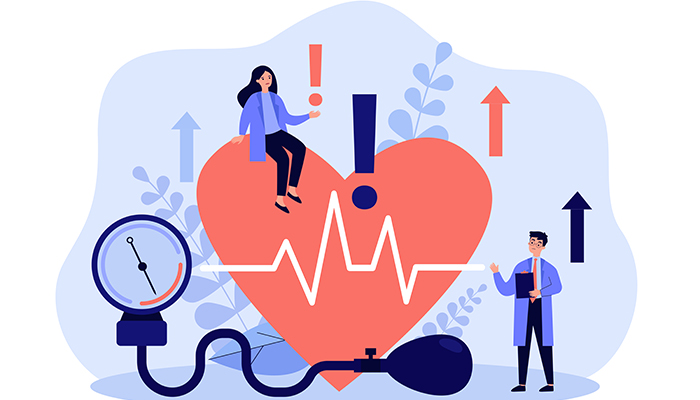The ultimate heart health checklist from Cardiology Jupiter
The ultimate heart health checklist from Cardiology Jupiter
Blog Article
Understanding the Importance of Cardiology in Modern Medical Care Solutions
Cardiology plays a vital function in modern healthcare, specifically as heart problem continues to be the leading source of death worldwide. Developments in diagnostics and therapy have transformed person treatment, allowing earlier interventions and improved outcomes. The change in the direction of preventive cardiology empowers individuals to manage their wellness proactively. As technology remains to evolve, the assimilation of ingenious remedies might better redefine cardiology's impact on public wellness, prompting a closer exam of arising fads and their ramifications.
The Prevalence of Cardiovascular Disease and Its Influence On Public Wellness
Although cardiovascular disease stays the leading cause of fatality globally, its impact prolongs far beyond private clients to impact public health systems and economic climates. The high frequency of heart problem puts a considerable strain on medical care resources, necessitating boosted financing for rehab, avoidance, and therapy programs. Public health and wellness campaigns have to deal with risk factors such as excessive weight, cigarette smoking, and less active lifestyles, which add substantially to the rising incidence of heart conditions.Moreover, the financial worry connected with heart condition is tremendous, including not just straight medical costs but additionally indirect costs connected to lost performance and early death. Areas face obstacles in taking care of these prices, frequently bring about differences in healthcare accessibility and results. As the populace ages and lifestyle-related risks remain to intensify, the necessity for effective cardiology treatments ends up being extremely important. Subsequently, attending to cardiovascular disease is not just a matter of specific health and wellness but likewise a critical public health and wellness concern.
Advancements in Heart Diagnostics and Imaging Techniques
Recent advancements in cardiac diagnostics and imaging methods have revolutionized the area of cardiology, enhancing the capacity to keep track of and detect heart conditions. Methods such as heart MRI, CT angiography, and echocardiography have actually ended up being significantly sophisticated, providing detailed images of heart frameworks and features. These methods enable the very early identification of conditions like coronary artery condition, heart failure, and valvular disorders.Moreover, developments in non-invasive diagnostics, such as wearable technology and remote surveillance tools, have equipped individuals and health care service providers. These tools help with real-time tracking of heart rhythms and various other vital signs, leading to prompt treatments. Furthermore, synthetic intelligence is being incorporated into imaging analysis, improving precision and performance in medical diagnosis.
Advancements in Treatment Alternatives for Heart Conditions
Current advancements in cardiology have actually caused significant developments in therapy alternatives for heart disease. These include innovative surgical methods that enhance step-by-step end results and arising medications that use brand-new avenues for therapy. As the field evolves, these advancements play an essential role in enhancing person treatment and end results.
Advanced Surgical Techniques
Developments in medical techniques have actually changed the landscape of cardiology, using brand-new hope for clients with heart disease. Minimally invasive treatments, such as catheter-based treatments, have significantly decreased recovery times and medical facility stays. Techniques like robotic-assisted surgical treatment improve accuracy, enabling cosmetic surgeons to navigate intricate physiological frameworks with higher precision. Furthermore, developments in imaging modern technology help with real-time visualization throughout treatments, improving outcomes. Transcatheter aortic valve substitute (TAVR) exemplifies a development in treating aortic stenosis, making it possible for shutoff substitute without open-heart surgery. Additionally, hybrid techniques that incorporate surgical and catheter-based methods give customized solutions for different cardiac problems. These advanced medical techniques not only boost client safety and security however additionally expand treatment options, highlighting the important duty of innovation in modern cardiology practices.
Emerging Medicines and Therapies
As the landscape of cardiology remains to progress, emerging treatments and medicines play a pivotal role in enhancing treatment options for heart problems. Innovations such as novel anticoagulants and advanced lipid-lowering representatives have transformed the monitoring of heart diseases, substantially minimizing individual morbidity and death. Furthermore, the growth of genetics treatments and regenerative medication supplies encouraging methods for treating conditions previously regarded irreversible. Clinical trials are constantly disclosing the efficacy of these treatments, pressing the limits of standard therapies. The integration of digital wellness technologies facilitates individualized medication, allowing for tailored treatment plans based on hereditary and way of living elements. Collectively, these innovations highlight the vibrant nature of cardiology, improving individual end results and redefining requirements of treatment in contemporary health care.
The Function of Preventive Cardiology in Patient Treatment
Preventive cardiology plays an essential function in individual care by concentrating on the recognition of danger aspects that contribute to cardiovascular disease. Through way of living alteration approaches and very early discovery strategies, doctor can successfully minimize the occurrence of cardio events - Dr Garcia. This positive approach not only boosts client end results but likewise advertises long-term health and wellness
Risk Aspect Recognition
While cardio diseases stay a leading root cause of morbidity and death worldwide, effective risk aspect recognition serves as a foundation of preventative cardiology. Identifying threat factors such as high blood pressure, hyperlipidemia, diabetes, and household history is vital for early treatment. Healthcare specialists utilize various evaluating techniques to examine these factors, permitting for customized precautionary steps. Additionally, understanding a person's way of life selections, such as smoking cigarettes and physical inactivity, better educates risk evaluations. This complete examination makes it possible for medical professionals to develop tailored care plans intended at mitigating risks. By focusing on threat aspect recognition, healthcare systems can boost client results and lower the general problem of cardiovascular conditions, ultimately adding to boosted public health and wellness approaches and source allowance.
Way Of Living Modification Strategies
A wide variety of researches highlights the vital function of way of living alteration approaches in he said lowering cardio disease risk. These strategies incorporate nutritional adjustments, raised physical task, smoking cigarettes cessation, and weight administration. By embracing a heart-healthy diet plan abundant in fruits, vegetables, whole grains, and lean proteins, individuals can decrease cholesterol levels and blood stress. Routine exercise reinforces the heart and enhances total cardio health and wellness. Additionally, quitting smoking cigarettes greatly lowers the danger of heart problem and improves healing prices for those with status quo. Weight administration even more contributes to cardio health and wellness by reducing various other risk aspects such as diabetic issues and high blood pressure. Applying these way of living changes not just promotes specific health but likewise functions as a foundation of preventative cardiology in client treatment.
Very Early Detection Methods
Way of living adjustments considerably contribute to reducing heart disease threats, however they are most efficient when coupled with early discovery methods. Precautionary cardiology highlights the relevance of determining prospective heart problems before they rise right into major problems. Methods such as blood stress monitoring, cholesterol testing, and progressed imaging technologies like echocardiograms play essential duties in evaluating cardiovascular health. Biomarkers and genetic testing likewise enhance the precision of early discovery, permitting tailored preventive approaches. Regular cardiac risk examinations equip doctor to step in proactively, potentially stopping heart assaults and strokes (Cardiology care). By integrating these early detection techniques right into regular care, patients can gain from timely way of living treatments and targeted treatments, inevitably enhancing and enhancing outcomes high quality of life
Integrating Innovation Into Cardiology Practices
As improvements in technology remain to improve various areas, the integration of cutting-edge tools and systems into cardiology techniques has actually come to be essential for boosting patient treatment and outcomes. Telemedicine platforms allow cardiologists to check clients from another location, boosting access to care while minimizing the worry on health care facilities. Wearable tools, such as smartwatches, enable continuous heart price surveillance, informing both patients and medical professionals to possible concerns in real-time. Furthermore, expert system (AI) is being made use of to analyze huge quantities of heart information, aiding in early diagnosis and tailored therapy plans. Advanced imaging techniques, including 3D echocardiography, improve visualization of heart structures, causing extra precise treatments. Electronic wellness records (EHRs) simplify individual info administration, making sure that cardiologists have immediate access to important information. Together, these technical developments are transforming cardiology, advertising aggressive administration and improved health end results for people with cardiovascular conditions.
The Significance of Person Education And Learning and Engagement
Patient education and engagement play a pivotal duty in the monitoring of cardio health. By furnishing people with knowledge about their problems, therapy alternatives, and way of living adjustments, doctor encourage people to take an active read here duty in their treatment. This positive method can bring about improved adherence to recommended medicines, nutritional adjustments, and exercise routines, inevitably minimizing the risk of complications.Engagement additionally promotes a solid patient-provider connection, motivating open interaction and trust fund. When clients really feel informed and entailed, they are a lot more likely to voice worries and ask inquiries, which can result in much better clinical results. Additionally, instructional resources, such as workshops or digital systems, can enhance understanding and promote self-management approaches. In general, prioritizing person education and engagement is necessary for boosting cardio wellness, improving lifestyle, and reducing healthcare expenses related to cardio conditions.
Future Fads in Cardiology and Their Possible Influence

Frequently Asked Questions
What Way Of Life Changes Can Minimize Heart Condition Danger?
The present question addresses way of life modifications that can considerably decrease cardiovascular disease risk. Cardiology Jupiter. Taking on a balanced diet regimen, engaging in regular exercise, preserving a healthy and balanced weight, taking care of stress, and avoiding cigarette can significantly boost cardiovascular wellness
Just How Can I Acknowledge Very Early Signs of Heart Troubles?
Recognizing very early signs of heart issues involves surveillance symptoms such as breast discomfort, lack of breath, fatigue, and irregular heart beat. Timely awareness of these indicators can trigger essential medical examination and treatment for far better results.
What Are the Distinctions In Between Cardiologists and Cardiac Surgeons?
The differences in between cardiologists and cardiac doctors depend on their duties; cardiologists mostly take care of and diagnose heart problems through non-invasive techniques, while cardiac doctors perform operations to correct architectural heart problems. Each plays a crucial, distinctive function.

How Frequently Should I Get My Heart Health And Wellness Checked?
The regularity of heart wellness checks varies based on private risk elements. Usually, grownups need to go through analyses each to 2 years, while those with status quo might need even more regular evaluations as suggested by healthcare professionals.
What Role Does Genes Play in Heart Disease Threat?
Genetics considerably influences cardiovascular disease threat, with domestic patterns indicating resource acquired conditions. Particular genetics can predispose people to high blood pressure, cholesterol problems, and various other cardio problems, highlighting the relevance of genetic screening in assessing heart health. Heart condition continues to be the leading cause of fatality worldwide, its influence prolongs much beyond private patients to impact public wellness systems and economies. Public health and wellness initiatives need to address danger variables such as excessive weight, smoking, and inactive way of lives, which contribute considerably to the climbing incidence of heart conditions.Moreover, the economic concern linked with heart illness is tremendous, encompassing not only direct medical expenses however likewise indirect costs associated to shed performance and early death. Preventative cardiology plays a vital function in individual treatment by concentrating on the identification of danger aspects that contribute to heart condition. Man-made intelligence (AI) and machine learning are boosting diagnostics and individual tracking, enabling very early detection of heart conditions. The differences between cardiologists and heart doctors lie in their duties; cardiologists mostly handle and identify heart problems with non-invasive approaches, while cardiac doctors carry out surgical treatments to correct architectural heart concerns.
Report this page